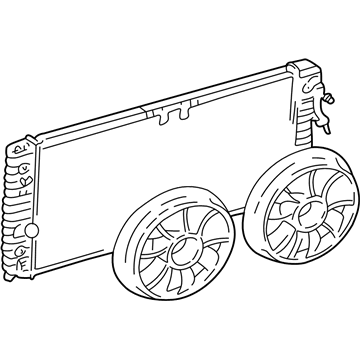ChevyParts
My Garage
My Account
Cart
OEM Chevrolet Classic Radiator fan
Radiator Cooling Fan- Select Vehicle by Model
- Select Vehicle by VIN
Select Vehicle by Model
orMake
Model
Year
Select Vehicle by VIN
For the most accurate results, select vehicle by your VIN (Vehicle Identification Number).
1 Radiator fan found
Chevrolet Classic Fan Blade Part Number: 12362564
$42.34 MSRP: $79.52You Save: $37.18 (47%)Ships in 1-2 Business Days
Chevrolet Classic Radiator fan
Want to cut long-term maintenance and repair costs? Choose OEM Radiator fan. Those parts deliver top durability you can trust. On our site, you'll find a huge catalog of genuine Chevrolet Classic parts. Prices are unbeatable, so you can keep more in your pocket. Every OEM Chevrolet Classic Radiator fan includes a manufacturer's warranty. You can also get an easy return policy that keeps buying risk free. Fast delivery, get your car on the road quickly. It's simple to search, compare, and order. Stop guessing about quality or fit. Order today and save with parts that last.
Chevrolet Classic Radiator fan Parts and Q&A
- Q: How to replace the radiator fan on Chevrolet Classic?A:The electric Radiator Fan replacement procedure starts with battery and battery tray removal followed by air conditioning system recovery then draining the cooling system fluids. The hose clamp pliers (J 38185) enables you to reposition the Radiator inlet hose clamp before removing the Radiator inlet hose from the Radiator. The next step involves relocating the drain valve on the surge tank outlet/Radiator outlet hose before extracting the surge tank outlet hose and Radiator vent hose and upper transaxle cooler line. The electrical connection of the refrigerant pressure sensor along with removal of the condenser inlet fitting from discharge hose requires capping or taping the open a/c discharge hose to stop contamination. The Radiator Fan electrical connectors get disconnected while the surge tank outlet/Radiator outlet hose bolt must be taken off from the Intake Manifold before raising the vehicle. Before removing the surge tank outlet/Radiator outlet hose from the Radiator it is essential to move the clamp to the Radiator while also disassembling the lower closeout panel. The technician removes the lower transaxle cooler line while also eliminating the bolt from the evaporator hose to the condenser then severs the evaporator hose and discards its sealing washer. You must first separate the lower Radiator support mounting panel before uninstalling the Radiator and fan with the condenser together as one unit. Separate the Radiator Fan Shroud from the Radiator before removing the fan nuts from the fans which allows the proper removal of the fans from the Fan Motors. Fasten the fans onto the fan motors through fan nut installation before torquing them up to 53 inches lb (6 Nm). Snap the Radiator Fan shroud onto the Radiator before installing the Radiator together with the fan and condenser assembly onto the vehicle and then securing the lower Radiator mounting panel with bolts at 10 nm (89 inch lbs.). After uninstalling tape or cap from the evaporator hose follow with a new sealing washer on the condenser end then link the evaporator hose to the condenser outlet securing the bolt at 25 nm (18 ft. Lbs.). The lower transaxle cooler line installation should start with 30 mm (22 in-lbs) of torque on the fitting. After that, install the surge tank outlet/Radiator outlet hose to the Radiator while readjusting the hose clamp positioning. Following the connection of Radiator Fan electrical wires you can install the lower closeout panel before lowering the vehicle. The surge tank outlet/Radiator outlet hose bolt should be attached to the Intake Manifold while the discharge hose gets its cap or tape removed to install a new seal washer before connecting and tightening the condenser inlet fitting to 25 nm (18 ft. Lbs.). Rejoin the refrigerant pressure sensor electrical connection and the upper transaxle cooler line while tightening it to 30 nm (22 ft. Lbs.) torque. Then install the Radiator vent hose and the surge tank outlet/Radiator outlet hose to the surge tank with legitimate placement of the hoseclamp where needed. The next step involves installing the Radiator inlet hose and repositioning its clamp followed by cooling system refilling then a/c system pressurization and employing the halogen leak detector (J 39400-A) to test component fittings before putting back the battery tray and inserting the battery.














